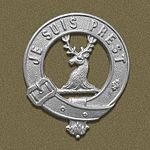History.
On the 12th of December in 1899 the 16th Lord Lovat & 22nd Chief of the clan Fraser, Simon Joseph Fraser approached the War Office to raise two companies of Scouts, one to be mounted the other on foot. Each company would be formed and made up of 236 men, eighty men were selected for stalking and spotting, the remainder were to be specialist marksmen, good riders, signallers etc.. These proposals were accepted and by January 1900, 1,500 men had volunteered. These volunteers were split into three contingents the first arriving in South Africa to fight the Boers. They arrived in January 1900 and remained there until August 1901. The second and third contingents were sent to help and reinforce the first contingent in May 1901 and August 1902, suffering many hardships and proving their skills by playing the Boers at their own game.
It was from the Large Shooting Estates in Scotland that most of Lovat Scouts came from, they were the Keepers, Stalkers and Ghillies that were chosen for their skills and expertise in shooting, tracking and spotting that made them so special.
The Lovat Scouts were mobilised again in August 1914 and they began training at Huntingdon. Shortly after training had started they were sent to Sutton -on - Sea and to Skegness to prevent an invasion. They remained there until the 15th of April 1915. On August the 21st they were sent to Gallipoli to fight the Turks. Again the Scouts skills in tracking, spotting, patrolling and sniping began to take a heavy toll on the Turks. However, sickness took a heavy toll on the Scouts and dysentery almost killed Lord Lovat himself. The Scouts remained in the Mediterranean fighting in Egypt and Macedonia until June 1918 when they then moved to the Western Front in July 1918, where they were joined by the Lovat Scouts Sharpshooters.
When Lord Lovat returned to Scotland after recovering from his illness he began to raise a new company called Lovats Sharpshooters. These scouts were most unusual as they were all advanced in years, the youngest 42 and the eldest was 2nd Liet CB MacPherson at 62. The Scouts also began the tradition of supplying instructors to the Army school of Observation and Sniping and continued to do this until 1948. It was here that the Scouts, introduced to the British Army, the now famous Ghillie suit.
A total of 481 Scouts lost their lives in WW1 and their names can be found at Edinburgh Castle.
Many former Lovat Scouts were found in many elite units, the Commandos the most famous being Lord Lovats No 4 Commando who's commander in chief was Lord Lovat himself, several went on to join the GHQ Liaison Regiment "Phantom" another unit was called "Popski's while others joined the SAS etc.
The Lovat Scouts guarded the Royal Family at Balmoral during the war.
The Lovat Scouts skills were again called up on to track down and hunt Nazi high ranking party members trying to escape out of Austria back to Germany during the Armistance Period from May 1945 to July 1945.
For more information about Lord Lovat's Scouts there are many sites to be found on the Internet.

Cap Badge of the Lovat Scouts.